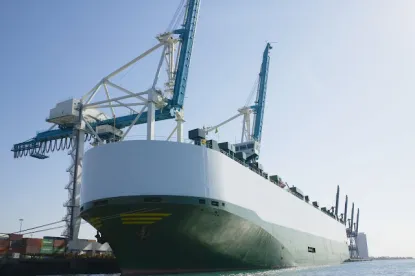The United States Fifth Circuit Court of Appeals recently decided a noteworthy case that has the potential to impact the allocation of risk and liabilities in the oceangoing cargo transportation industry. In GIC Services, LLC v. Freightplus USA, Inc., 866 F.3d 649 (5th Cir. 2017), the Fifth Circuit concluded for the first time that the “special relationship” between a non-vessel-operating common carrier (NVOCC) and a vessel-operating common carrier (VOCC) is one of the limited situations that may give rise to a claim for maritime tort indemnification. This conclusion is significant in that it provides a unique remedy to an NVOCC that suffers loss due to the negligence of a VOCC, and vice versa.
In GIC Services, LLC, a party contracted with an NVOCC to arrange the transportation of a tugboat from Houston, Texas, to Nigeria. Because the NVOCC itself was not capable of physically transporting the tugboat, the NVOCC contracted with a broker, which in turn entered into a contract with a VOCC to transport the tugboat to Nigeria. During the transport of the tugboat, a dispute arose among the parties as to the contractually required port of discharge. The VOCC argued it was obligated to deliver the vessel to Warri, Nigeria, because the broker identified Warri as the port of discharge. The VOCC also generated a booking note, cargo manifest, and bill of lading listing Warri as the port of discharge. The other parties, however, believed that the contractual port of discharge was Lagos, Nigeria, based on bills of lading issued by the broker and the NVOCC identifying Lagos as the port of discharge.
After the vessel was ultimately delivered to Warri, Nigeria, suit was filed against the NVOCC for damages due to improper discharge. The VOCC was added as a party as well. Following a two-day bench trial, the United States District Court for the Eastern District of Louisiana concluded, inter alia, that Lagos was the contractually required port of discharge, and that the NVOCC was liable to the shipper for $1,860,985 in damages as a result of the improper port of discharge. Of significance, the district court also concluded that the VOCC was responsible for 30 percent of the shipper’s damages, ordering the VOCC to indemnify the NVOCC for 30 percent of the $1,860,985 damages award even though the VOCC and the NVOCC were not contractual counterparties.
On appeal, the Fifth Circuit affirmed the district court on these issues, providing insight into the now-limited but formerly “prominent feature of maritime law” known as maritime tort indemnification. Although maritime law once provided for various tort indemnity theories, the Supreme Court curtailed the availability of tort indemnity under maritime law and replaced it almost entirely with the doctrine of comparative fault in United States v. Reliable Transfer Co., 421 U.S. 397 (1975).
Since the Supreme Court’s 1975 decision in Reliable Transfer, maritime tort indemnification has been available only in limited situations. The Fifth Circuit recognizes three situations in which maritime tort indemnity remains available: (1) when there is a “special relationship” between the indemnitor and the indemnitee, (2) when there is a significant difference in the indemnitor’s and the indemnitee’s degree of conduct, and (3) when there is a difference in the character of the duties owed by the indemnitor and the indemnitee to the injured party. Prior to the Fifth Circuit’s decision in GIC Services, LLC, courts appeared to limit the first situation, requiring the existence of a “special relationship,” to the relationship between a stevedore and a shipowner. For example, the Fifth Circuit has recognized that maritime law imposes on shipowners a duty of care to longshoremen, and thus, a shipowner’s breach of its duty gives rise to a cause of action by the stevedore to recover payments made by the stevedore to a longshoreman injured because of the shipowner’s negligence.
In GIC Services, LLC, the Fifth Circuit recognized an additional “special relationship” giving rise to maritime tort indemnity. Indeed, following decisions of the Third Circuit and the Eleventh Circuit, the Fifth Circuit concluded that the special relationship between an NVOCC and a VOCC is one of the limited situations that may give rise to a claim for maritime tort indemnification. The Fifth Circuit found in this case that although the NVOCC was the contractual counterparty of the shipper and directly responsible to the shipper for ensuring the delivery of the vessel in Lagos, the VOCC’s negligence contributed to the wrongful discharge of the vessel in Warri. As such, the VOCC was required to indemnify the NVOCC for 30 percent of the damages award, as the trial court concluded that the VOCC was 30 percent responsible therefor.
The Fifth Circuit’s decision in GIC Services provides insight into the concept of maritime tort indemnification in the oceangoing cargo transportation industry, as well as analogous situations where special relationships exist between the parties. Although indemnification for maritime torts is available only in limited situations, the Fifth Circuit has now made clear that the special relationship between NVOCCs and VOCCs is one of the limited situations that may give rise to a claim for maritime tort indemnification.




 />i
/>i
